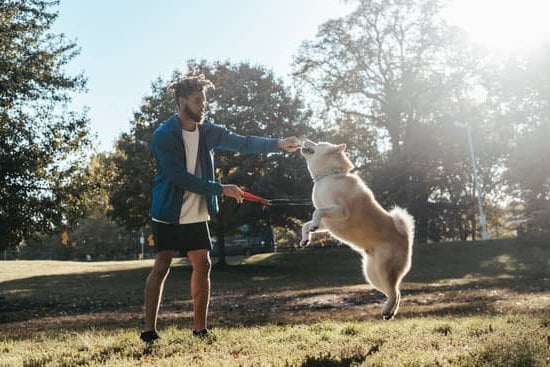When deciding to bring a dog into your life, one of the first considerations should be their trainability. Training is crucial for a dog’s overall well-being and ensures that they can live harmoniously with their owners and in society.
In this article, we will explore the importance of choosing an easy-to-train dog breed and the benefits it brings. By understanding the traits of easily trainable dogs and exploring the top 5 breeds in this category, readers will gain valuable insights on which furry friend may be the perfect fit for their training journey.
Training dogs goes beyond teaching them basic commands; it is a key factor in their mental and emotional development. Dogs are social animals that thrive on structure and boundaries, making training essential to provide them with a sense of security and purpose. Well-trained dogs are often happier, more confident, and less likely to engage in destructive behaviors.
Additionally, an obedient dog is safer both within the home and when out in public spaces. They are less likely to exhibit aggressive or unwanted behavior towards people or other animals.
Owning an easily trainable dog comes with numerous benefits. Not only does it make training efforts less frustrating for owners, but it also opens up a wide range of activities that can be enjoyed together. Easily trainable dogs excel in agility courses, obedience competitions, and various dog sports due to their quick learning abilities.
Furthermore, these breeds tend to have better problem-solving skills, making them adaptable to new environments or situations. With these advantages in mind, let’s delve into the traits of an easily trainable dog.
Exploring the Traits of an Easily Trainable Dog
When considering which dog breed to bring into your home, it’s important to understand the traits of an easily trainable dog. These characteristics play a crucial role in training success and can make the process much smoother and more enjoyable for both you and your four-legged companion.
One of the key traits to look for in an easy-to-train dog is intelligence. Intelligent breeds are quick to grasp commands and concepts, making them easier to train. Breeds such as the Labrador Retriever, Border Collie, Golden Retriever, Poodle, and German Shepherd are known for their high intelligence levels and eagerness to learn.
Temperament also plays a significant role in training success. Dogs with a calm and friendly disposition are often more receptive to training methods. They tend to be more patient, adaptable, and less likely to exhibit stubborn behavior during training sessions. It’s important to remember that individual dogs within a breed can have varying temperaments, so take the time to get to know the specific traits of each dog you are considering bringing into your family.
| Breed | Intelligence Level (Out of 10) | Trainability Score (Out of 10) |
|---|---|---|
| Labrador Retriever | 9 | 8 |
| Border Collie | 10 | 9 |
| Golden Retriever | 8 | 8 |
| Poodle | 9 | 8 |
| German Shepherd | 9 | 8 |
Top 5 Easiest Dog Breeds to Train
The top 5 easiest dog breeds to train are Labrador Retrievers, Border Collies, Golden Retrievers, Poodles, and German Shepherds. These breeds have proven to be highly trainable due to their intelligence, temperament, and eagerness to please their owners.
Labrador Retrievers are known for their quick learning abilities and charismatic personalities. They excel in obedience training and are often used as service dogs or assistance animals. Their friendly nature and desire to please make them a great choice for first-time dog owners looking for an easy-to-train companion.
Border Collies, on the other hand, are renowned for their masterful obedience skills and agility. They are highly intelligent working dogs that require mental stimulation and physical exercise. With the right guidance and training techniques, Border Collies can learn complex commands and tasks quickly.
Golden Retrievers are another popular choice among dog owners seeking an easily trainable breed. They possess high levels of intelligence, responsiveness, and an eagerness to please their owners. These qualities make them ideal candidates for obedience training, therapy work, or other specialized training programs.
Poodles are often considered one of the smartest dog breeds. Their exceptional intelligence coupled with their versatility allows them to excel in various activities such as dog sports and obedience competitions. Poodles have a natural ability to understand commands quickly and enjoy participating in training sessions.
German Shepherds round out the list of top 5 easiest dog breeds to train due to their loyalty, intelligence, and natural inclination towards learning. They are commonly used as police or military dogs due to their trainability and ability to comprehend complex commands. German Shepherds thrive in environments where they receive consistent training sessions and mental stimulation.
These five breeds offer a winning combination of trainability traits that make them stand out as the easiest dogs to train. Whether you’re a first-time owner or an experienced trainer looking for a new challenge, these breeds can provide both companionship and a rewarding training experience.
Factors That Influence Trainability
When it comes to training a dog, several factors can influence their ability to learn and respond to commands. Understanding these factors can help dog owners choose a breed that is more easily trainable and increase the chances of training success. In this section, we will explore three important factors that influence trainability: a dog’s age, breed and genetics, and socialization.
A Dog’s Age
Age plays a significant role in a dog’s trainability. While puppies have the advantage of being more adaptable and open to new experiences, they also have shorter attention spans and may be easily distracted.
On the other hand, adult dogs tend to have longer attention spans but may already have established habits or behaviors that require more effort to change. It is important to consider your own lifestyle and availability when choosing the age of a dog for training purposes.
Breed and Genetics
It is well-known that certain dog breeds are more naturally inclined towards training than others. This is often due to their breed traits and genetic predispositions.
Breeds such as Labrador Retrievers, Border Collies, Golden Retrievers, Poodles, and German Shepherds are frequently mentioned as some of the easiest dog breeds to train due to their intelligence, willingness to please, and ability to quickly understand commands. However, it is essential to remember that each individual dog within a breed may vary in temperament and response to training methods.
Socialization
Socialization plays an integral role in a dog’s overall behavior development and trainability. Starting from an early age, exposing your dog to different people, animals, environments, sights, sounds, smells can help them become well-adjusted adults with fewer behavioral issues. Dogs who are properly socialized tend to be more confident and adaptable when faced with new situations during training sessions.
By considering these factors when selecting a dog for training, dog owners can make a more informed decision and increase their chances of successfully training their furry companions. It is important to remember that regardless of the breed or age, every dog has its own unique personality and may require individualized training approaches.
Training Techniques for Easy-to-Train Dogs
When it comes to training a dog, regardless of their breed, certain techniques can be particularly effective for easy-to-train dogs. These techniques focus on positive reinforcement and clear communication to encourage desired behaviors. By utilizing these training methods, owners can foster a strong bond with their canine companions and achieve successful results.
One popular training technique for easy-to-train dogs is the use of positive reinforcement. This method involves rewarding the dog for displaying desired behaviors, such as sitting or staying when commanded. Treats, praise, or playtime are commonly used as rewards to reinforce the behavior positively. By associating good behavior with positive outcomes, the dog learns that obeying commands leads to enjoyable experiences.
Another technique that can be effective for training easy-to-train dogs is clicker training. Clicker training involves using a small handheld device that makes a distinct clicking sound when pressed. The clicker serves as a marker to indicate when the dog has done something correctly.
Initially, the click is paired with a treat or reward to establish the connection between the click and positive reinforcement. Over time, the click itself becomes reinforcing, allowing for precise timing in marking desired behaviors.
Consistency is key when training any dog but particularly important for easy-to-train breeds. It is essential to establish consistent rules and expectations from the start and stick to them throughout the training process. Additionally, maintaining patience is crucial when training an easy-to-train dog because even though they may learn quickly, they still require time and repetition to solidify their understanding of commands.
Clear communication is also vital when working with an easy-to-train dog. Using clear commands in a firm yet gentle tone helps ensure that your dog understands what you expect from them. Avoiding ambiguous language and providing cues through body language or vocal cues further aids in effective communication.
By employing these training techniques – positive reinforcement, clicker training, consistency, and clear communication – owners of easy-to-train dogs can create a positive and productive training experience. These techniques not only promote desired behaviors but also strengthen the bond between owner and dog, resulting in a well-behaved and happy furry companion.
Early Socialization and Obedience Training
Early socialization and obedience training play a crucial role in shaping a dog’s behavior and overall development. It is during this critical period that puppies are most receptive to learning, making it an ideal time to introduce them to basic obedience commands and social experiences. By starting early and providing consistent training, owners can establish a strong foundation for their dog’s future behavior.
The Significance of Early Training and Socialization
Early training and socialization help puppies develop important life skills and learn how to interact with the world around them. During this period, which typically lasts from birth until around 16 weeks of age, puppies are highly adaptable and open to new experiences. Exposing them to various people, animals, sounds, objects, and environments helps them develop confidence and reduces the likelihood of fear or aggression later in life.
Obedience training is also crucial during this stage as it establishes boundaries, teaches basic commands such as sit, stay, come, and establishes good manners. Basic obedience lays the foundation for more advanced training later on and ensures that the puppy grows up into a well-behaved adult dog.
Tips for Introducing a Puppy to Basic Obedience Commands and Social Experiences
When introducing a puppy to basic obedience commands and social experiences, consistency is key. Here are some tips to make the process smoother:
- Start slow: Begin with simple commands like “sit” or “come” in familiar surroundings where there are minimal distractions.
- Use positive reinforcement: Reward your puppy with treats or praise when they exhibit desired behaviors. This positive association motivates them to repeat those behaviors.
- Keep sessions short: Puppies have short attention spans, so keep training sessions brief (about 10-15 minutes) but frequent throughout the day.
- Gradual exposure: Introduce your puppy to new experiences gradually by slowly increasing the level of difficulty or complexity. For example, start exposing them to new people or dogs in controlled environments before moving on to more challenging scenarios.
- Socialization opportunities: Take your puppy to puppy classes, dog parks, and other social situations where they can interact with other dogs and people. Ensure that these experiences are positive and supervised for safety.
By following these tips, owners can help their puppies develop the necessary skills and confidence to become well-rounded and obedient adult dogs. Early socialization and obedience training lay the foundation for a lifetime of positive behavior and make it easier to train as they grow older.
Training Challenges and How to Overcome Them
Addressing stubbornness or reluctance in training
One of the common challenges that dog owners may face when training their furry friends is stubbornness or reluctance. Some dogs may be more independent-minded or less motivated to learn, making the training process more challenging. However, there are strategies to address this issue and overcome it:
- Patience and persistence: It’s important to remember that training takes time and effort, especially with dogs that are naturally stubborn. Consistency and repetition are key. Use positive reinforcement techniques consistently and be patient with your dog’s progress.
- High-value rewards: Find treats or rewards that your dog finds highly motivating. Using high-value rewards can help increase your dog’s interest and motivation during training sessions, making them more willing to learn. Experiment with different treats or toys to find what works best for your dog.
- Break tasks into smaller steps: If your dog seems overwhelmed or resistant when learning a new command or skill, try breaking it down into smaller steps. This will make the task more manageable for your dog and increase their chances of success.
Dealing with distractions and staying focused during training sessions
Distractions can easily derail training sessions, especially for easily excitable dogs or breeds with a high prey drive. Here are some tips for dealing with distractions and helping your dog maintain focus:
- Start in a low-distraction environment: When introducing a new command or skill, begin in an environment where there are minimal distractions. This could be inside your home or in a quiet backyard before gradually increasing the level of distractions.
- Gradually increase difficulty: As your dog becomes more comfortable and proficient with a command in a controlled environment, gradually introduce distractions one at a time. For example, start by having someone walk by quietly while practicing the command before progressing to louder noises or other dogs nearby.
- Use leash or spatial management: If your dog is easily distracted, consider keeping them on a leash or using a physical barrier to limit their movement during training sessions. This can help maintain their focus and prevent them from wandering off or becoming overly stimulated by external stimuli.
Troubleshooting common training issues and finding effective solutions
While each dog is unique, certain training issues tend to arise regardless of breed or temperament. It’s essential to address these problems promptly and find effective solutions. Here are some tips for troubleshooting common training issues:
- Consistency and repetition: Ensure that you are consistent in your commands, rewards, and expectations throughout the training process. Inconsistencies can confuse your dog and hinder their progress.
- Seek professional help if needed: If you’re struggling with specific training challenges despite your best efforts, don’t hesitate to seek guidance from a professional dog trainer. They can provide personalized advice and techniques tailored to your dog’s individual needs.
- Modify techniques as necessary: Not all dogs respond to the same training methods. If you find that a particular technique is not working for your dog, be flexible and open-minded in trying different approaches. Adapt the training method to suit your dog’s learning style.
By addressing stubbornness or reluctance, dealing with distractions effectively, and troubleshooting common training issues, you can overcome obstacles that may arise during the training process. Remember that every dog is unique, so it’s important to be patient, adaptable, and tailor the training approach to suit their individual needs. With time and effort, even the most challenging dogs can become well-trained companions.
Additional Resources for Easy-to-Train Dog Breeds
When it comes to training your easy-to-train dog, having additional resources can be immensely helpful. Whether you are a first-time dog owner or a seasoned trainer, these resources can provide valuable guidance and support throughout the training process. Here are some recommended books and websites that can assist you in training your easy-to-train dog breed:
1. Books:
- “The Power of Positive Dog Training” by Pat Miller: This book emphasizes the use of positive reinforcement techniques and offers step-by-step instructions for training various commands and behaviors.
- “Don’t Shoot the Dog.: The New Art of Teaching and Training” by Karen Pryor: This classic book explores the science behind animal training and provides practical advice for effective training methods.
- “The Puppy Primer” by Patricia B. McConnell and Brenda Scidmore: Perfect for those with puppies, this book focuses on early socialization, basic obedience, and preventing common behavioral problems.
2. Websites:
- The Association of Professional Dog Trainers (APDT): APDT’s website offers a wealth of information on positive reinforcement training techniques, as well as a searchable directory to find certified trainers in your area.
- American Kennel Club (AKC) Canine College: AKC’s Canine College provides online courses covering various topics such as obedience training, canine sports, and behavior modification.
- clickertraining.com: Run by world-renowned trainer Karen Pryor, this website offers articles, videos, and an online store for clicker training supplies.
In addition to books and websites, enrolling in local dog training classes or seeking guidance from professional trainers who specialize in easy-to-train breeds can be beneficial. These experts can provide personalized advice tailored to your specific dog’s needs and help address any challenges or questions that may arise during the training process.
Remember that while these resources can offer valuable information, consistent practice, patience, and clear communication with your dog are key to successful training. Every dog is unique, so it’s important to adapt the techniques and methods to suit your dog’s individual personality and learning style. With the right resources and a positive mindset, you can enjoy a fulfilling training journey with your easy-to-train dog breed.
Conclusion
In conclusion, choosing an easy-to-train dog breed is essential for a harmonious and fulfilling relationship with your furry companion. Throughout this article, we have explored the traits that make a dog easily trainable and discussed the top five easiest dog breeds to train.
We have also examined the factors that influence a dog’s trainability and highlighted effective training techniques for easy-to-train dogs. Additionally, we emphasized the importance of early socialization and obedience training in shaping a dog’s behavior.
When it comes to finding the perfect easy-to-train dog for you, it is crucial to consider your lifestyle and preferences. Each of the top five easiest dog breeds mentioned in this article has its own unique characteristics and requirements. For example, Labrador Retrievers are charismatic and intelligent, making them great family pets.
Border Collies excel in obedience and agility, but they require plenty of physical exercise and mental stimulation. Golden Retrievers are known for their intelligence and eagerness to please, while Poodles are versatile and thrive in various dog sports.
Regardless of which breed you choose, it is important to remember that training is an ongoing process that requires consistency, patience, and clear communication from both sides. If you need additional guidance or support along the way, there are plenty of resources available such as books, websites, or local dog training classes.
By selecting an easy-to-train dog breed that aligns with your lifestyle and dedicating time to proper training and socialization from an early age, you can ensure a well-behaved companion who brings joy to your life for years to come.
So take your time researching different breeds, considering their traits and needs; ultimately finding the perfect easy-to-train dog breed for you will be a rewarding experience that strengthens the bond between you and your four-legged friend.
Frequently Asked Questions
What’s the easiest trained dog?
The easiest trained dog is often considered to be the Border Collie. This intelligent breed consistently ranks at the top in terms of trainability. Border Collies are known for their exceptional intelligence, eagerness to please their owners, and natural herding instincts.
Their ability to understand and carry out complex commands quickly makes them ideal candidates for obedience training and various dog sports. With proper guidance and positive reinforcement, these dogs can excel in mastering a wide range of commands and tasks.
What is the hardest dog to train?
While every dog has the capacity to learn, some breeds might present more challenges when it comes to training. One breed that is frequently mentioned as being particularly hard to train is the Afghan Hound. Known for its independent nature and aloof demeanor, this noble-looking breed tends to have a somewhat stubborn streak.
Afghan Hounds can be selective about listening to commands or following instructions as they prefer to do things on their own terms. Patience, consistency, and creative training techniques are key when working with an Afghan Hound.
What’s the smartest and the easiest dog to train?
When considering both intelligence and ease of training, one particularly noteworthy breed is the Labrador Retriever. Labs consistently rank among the smartest dogs due to their innate problem-solving abilities, high energy levels, and social nature. Their willingness to please their owners combined with their quick learning capabilities makes them highly trainable companions for many households.
Labrador Retrievers excel in obedience training, agility trials, search and rescue work, and even therapy roles. Additionally, their friendly and adaptable nature makes them great family pets that respond well to positive reinforcement-based training methods

Welcome to the blog! I am a professional dog trainer and have been working with dogs for many years. In this blog, I will be discussing various topics related to dog training, including tips, tricks, and advice. I hope you find this information helpful and informative. Thanks for reading!





